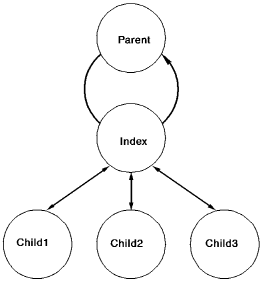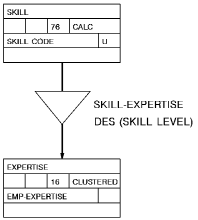

CA IDMS/DB supports the following types of linked relationships:

Guidelines
As a general rule, use indexed for nonclustered relationships and chained for clustered relationships.
An indexed nonclustered relationship requires fewer I/Os to add or remove an entity occurrence than a chained nonclustered relationship. This is because the adjacent entity occurrences are not updated; only the index structure needs to be updated. In addition, fewer I/Os are required to retrieve a child occurrence by key in a nonclustered relationship if it is indexed rather than chained.
A chained relationship, on the other hand, requires less CPU overhead for maintenance and retrieval than an indexed relationship. It also requires less storage space because there is no index structure. For these reasons, it is a better choice than indexed for clustered relationships because I/Os are not generally a concern.
Note: For databases implemented with SQL, all linked clustered relationships are chained and all linked nonclustered relationships are indexed.
For further information on the structure of indexed relationships, see Chapter 15, "Determining the Size of the Database".
For further information on indexed relationships, see CA IDMS Database Administration Guide.
A comparison of indexed and chained relationships
The following table presents a comparison of indexed relationships and chained relationships.
|
Efficiency Considerations |
Potential Impact |
|---|---|
|
I/O |
Indexed relationships often require fewer I/O operations to access child entities in nonclustered relationships, especially if the relationship is sorted. |
|
CPU time |
Chained relationships use less CPU time for processing of child entities than indexed relationships. |
|
Space management |
Chained relationships require less storage space than indexed relationships. |
|
Contention |
No difference. |
Representing an indexed relationship
To represent an indexed relationship:
The following diagram shows the standard CA IDMS/DB notation for an indexed relationship. The index allows the DBMS to access all EXPERTISE occurrences associated with a particular skill based on skill level in descending order.

|
Copyright © 2014 CA.
All rights reserved.
|
|